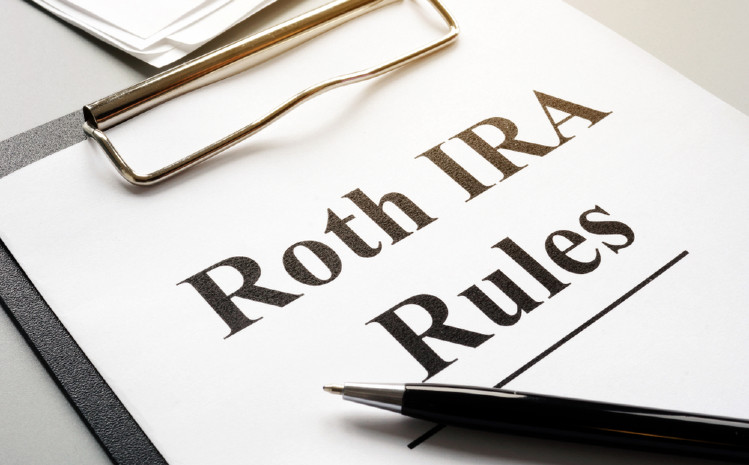The Roth IRA distribution rules should be pretty simple. Make sure the Roth IRA is open at least five years and wait until you are over the age of 59 1/2 and all Roth IRA distributions should be tax-free. However, like almost any rule in the tax code, there are an assortment of exceptions that make a simple rule, actually quite complex.
- Qualified Roth IRA Distribution are tax-free
- One must be at least 59 1/2 years old and the oldest Roth IRA must be opened for at least five years
- The rules vary based on how the plan was funded
As a tax attorney, I have been dealing with the Roth IRA distribution rules for over twenty years. I have written eight books on retirement accounts and finally decided that it is time to write a short and simple blog that covers all the Roth IRA and Roth 401(k) plan distribution scenarios simply and clearly. So here we go….
What is a Roth IRA?
The Roth IRA is an after-tax IRA that allows any US person with earned income under a set income threshold (under $161,000 if single and $240,000 if married and filing jointly) to make after-tax contributions up to $7,000 or $8,000 if over the age of 50 in 2024. So long as the Roth IRA has been opened at least 5 years and the Roth IRA has been opened at least 5 years, all Roth IRA distributions would be tax-free. Also, with a Roth IRA, there are no RMDs.
Roth IRA Distribution Rules
When analyzing the Roth IRA distribution rules, it is important to examine them based on the origin of the Roth IRA funds. In other words, breaking down where the Roth IRA funds came from: Roth IRA contributions and/or Roth IRA conversions.
Roth IRA Contributions
To contribute to a Roth IRA you must have taxable compensation, such as wages, salaries, commissions, tips, bonuses, or net income from self-employment. For tax years beginning after 2024, there is no age limit to contribute to a traditional IRA. Compensation for purposes of contributing to an IRA doesn’t include earnings and profits from property, such as rental income, interest, and dividend income, or any amount received as pension or annuity income, or as deferred compensation.
In the case of a Roth IRA contribution, in general, if one is over the age of 59 1/2 and the Roth IRA has been funded and opened at least five years, the Roth IRA distribution will be a “qualified” distribution and the entire distribution would be tax-free.
Related: Tax-Free vs Tax Deferred
Five-Years
The rules for courting the five-year rules are a bit peculiar. For example, a Roth IRA contribution made in April 2024 will still count as a contribution for the 2023 tax year. The rule basically gives you credit as if you made the contribution on January 1, 2023, which means the first year of a potential qualified distribution would be 2028. In addition, once you have made a Roth IRA contribution, the clock starts ticking for all Roth IRAs in the aggregate. In other words, once you satisfy the five-year rule, you will have satisfied it for every Roth IRA in the future. Note – there is a separate five-year rule for each 401(k) plan you have participated in.
Non-Qualified Distributions
Whereas, if the Roth IRA distribution is not a “qualified” distribution, either because any Roth IRA was not opened at least five years or the Roth IRA holder was under the age of 59 1/2, then one must look at the Roth IRA distribution ordering rules to determine what percentage of the Roth IRA distribution would be taxable and subject to income tax and potentially a 10% early distribution penalty. This is where the distinction between Roth IRA contributions and Roth IRA earnings comes into play.
Contributions vs. Earnings
Roth IRA contributions
Roth IRA Contributions can always be taken as a tax-free distribution at any time. In other words, if you make a Roth IRA contribution on March 1, 2024, you can take the entire amount of Roth IRA contributions as a distribution on March 2, 2024, and pay no tax or penalty. This is the case even if you are under the age of 59 1/2 and/or the Roth IRA has been opened less than five years. The idea behind this rule is that since the Roth IRA contribution is with after-tax funds, there is no IRS tax loss for allowing the contribution to be taken back immediately. It is important to note, that the rules for Roth IRA conversions are quite different.
Roth IRA Earnings
Roth IRA earnings means the income and gains generated from the Roth IRA contributions. In other words, contributions are what you put into the Roth IRA from your personal income or compensation. Whereas, the earnings are the investment returns from the Roth IRA contributions.
In sum, when it comes to taking a distribution of Roth IRA earnings, the Roth IRA owner must be over the age of 591/2, and the Roth IRA must be opened and funded for at least five years for the distribution of Roth IRA earnings to be tax and penalty-free. The five-year clock starts ticking as soon as the Roth IRA was funded. For example, if Lisa contributed $5,000 to a Roth IRA on May 5, 2023, at age 23, Lisa would be able to take the entire $5,000 as a tax-free distribution anytime. However, if on September 2, 2024, the $5,000 of contributions generated $1,100 of earnings, for a Roth IRA total asset value of $6,100, Lisa would have to wait until she was 59 1/2 and the Roth IRA was opened at least five years before taking a tax-free distribution of the $1,100. Any distribution of the Roth IRA earnings ($1,100) would be subject to income tax and a 10% early distribution penalty.
Roth IRA Conversions
A Roth IRA conversion occurs when one converts a pre-tax IRA to Roth IRA. The benefit of doing a Roth IRA conversion is that one is able to turn pre-tax IRA funds that will ultimately be subject to tax upon a distribution and a required minimum distribution (RMD) after the age of 73 to tax-free income. The downside is that a Roth IRA conversion is subject to income tax based on the value of the pre-tax IRA that was converted. Whereas, a Roth IRA is not subject to any RMDs and any distribution of converted Roth IRA funds could be tax-free, subject to certain restrictions. Let’s get into the different Roth IRA conversion distribution scenarios, which are a bit more complex than the Roth IRA contribution distribution rules.
Backdoor Roth IRA
Since 2010 the backdoor Roth IRA strategy has been used by high income earners that make roth IRA contributions. For 2024, if one is married filing jointly and makes in excess of $240,000 or $161,000 if single, they are technically not permitted to make roth IRA contributions. However, since 2010 the IRS removed any income restrictions for making roth conversions. Hence, in 2024, anyone can make a roth IRA contributions either directly or via a backdoor roth IRA irrespective of income.
Making a backdoor roth IRA can be best understood in a few short steps:
- Open a traditional IRA
- Make an after tax traditional IRA contribution. Do not treat the IRA contribution as tax deductible on your tax return.
- Make an IRA contribution for 2024 of up to $7000 or $8000 if over 50
- Notify your IRA custodian that you want to convert the after-tax traditional IRA to roth
- Funds are transferred to roth IRA
- IRA custodian issues a 1099-R in the following year indicating that a no tax conversion occurred.
Conversions of after-tax funds to Roth IRA are not subject to the five-year rule for the contributed amount, but earnings are subject to the 59 1/2- and five-year rule. Hence, if one converted after-tax IRA funds to Roth and is under the age of 59 1/2, one can take the amount converted to Roth IRA anytime without tax or penalty. While pre-tax IRA funds converted to Roth, would be subject to the five-year rule if the Roth IRA owner is under the age of 59 1/2
Pre-tax IRA Converted to Roth
When one converts a pre-tax IRA to a Roth IRA, there is a set of ordering rules that must be used to determine the tax impact of a Roth IRA distribution:
The first item to examine when determining when a Roth IRA of converted funds would be taxable is the five-year rule. If one is under the age of 591/2 and does a Roth IRA conversion, one must wait at least five years to take out the converted amount as a Roth IRA distribution tax-free. Just like the quirky Roth IRA contribution timing rules, the Roth IRA conversion is deemed to have occurred as of January 1st of that year, even if the conversion was made on December 31. In other words, unlike a Roth IRA contribution which allows Roth IRA contributions to be taken out tax-free at any time, when it comes to a Roth IRA conversion of pre-tax funds, if the Roth IRA owner is under the age of 59 1/2, he or she must wait at least five years before taking a tax-free distribution of the converted Roth IRA amount.
In the case where a Roth IRA distribution is taken prematurely and is not a “qualified distribution,” the Roth IRA distribution would be subject to a 10% early distribution penalty.
However, if one is over the age of 59 1/2, one can take a distribution of the funds converted anytime without having to satisfy the five-year rules and pay no 10% early distribution penalty. Note – this exception only applies to the converted Roth IRA amount. Any earnings on the amount of funds converted to a Roth IRA can only be taken out tax-free if the Roth IRA owner is over the age of 59 ½ and the Roth IRA has been opened at least 5 years. In addition, unlike the five-year rule for Roth IRA contributions, in the case of Roth IRA conversions, each Roth IRA conversion amount has its own five-year time period, which means that the oldest Roth IRA conversions are withdrawn first, and the most recent conversions are withdrawn last.
For example, Lisa is 42 years old and elects to do a Roth conversion of $50,000 of pre-tax IRA funds on December 15, 2023. The Roth IRA conversion will be deemed to have occurred for the five-year rule on January 1, 2023. Since Lisa, is under the age of 59 1/2, she will have to wait five years before taking any of the $50,000 converted tax-free. Once Lisa is over the age of 59 1/2, she will have satisfied the five-year rule and can take a distribution of Roth IRA contributions and earnings tax-free. Hence, at age 60, if the Roth IRA was worth $235,000, she could take a tax-free distribution of all or some of the Roth IRA tax-free.
After-Tax IRA Converted to Roth
The rules for conversions of after-tax IRA funds to Roth are slightly different than the rules for pre-tax IRA conversions. After-tax IRA contributions are not tax deductible and are only made in very rare circumstances, such as for a backdoor Roth IRA.
Not all individual taxpayers are eligible to make Roth IRA contributions. For taxpayers filing as single, one must have a modified adjusted gross income under $139,000 to contribute to a Roth IRA for the 2020 tax year, but contributions are reduced starting at $124,000. For taxpayers filing as married, the combined modified adjusted gross income must be less than $206,000, with reductions beginning at $196,000. In essence, a backdoor IRA allows a high-income earner, who has exceeded the Roth IRA annual income contribution limits, to circumvent those rules and make the Roth IRA contribution.
Under Internal Revenue Code Section 408(d)(2), the aggregation rules hold that when an individual has multiple pre-tax IRAs, they will all be treated as one account when determining the tax consequences of any distributions (including a distribution out of the account for a Roth conversion). Hence, when converting an after-tax IRA to a Roth IRA, one has to take into account all other pre-tax IRAs to determine the percentage of the converted amount that will be eligible for the Roth conversion. Whereas, if one if converting after-tax IRA funds to Roth and does not have any pre-tax IRAs, then the entire amount of the after-tax IRA can be converted to Roth.
Conversions of after-tax funds to Roth IRA are not subject to the five-year rule for the contributed amount, but earnings are subject to the 59 1/2- and five-year rule. Hence, if one converted after-tax IRA funds to Roth and is under the age of 59 1/2, one can take the amount converted to Roth IRA anytime without tax or penalty. While pre-tax IRA funds converted to Roth, would be subject to the five-year rule if the Roth IRA owner is under the age of 59 1/2
Roth 401(k) Plan Rollover to a Roth IRA
One of the most popular ways of funding a Roth IRA is through a rollover. In general, one can only rollover funds from a 401(k) plan if you have satisfied a plan-triggering event. A plan-triggering event typically occurs when you reach the age of 59 1/2, leave your job or the plan is terminated. Otherwise, other than for a hardship distribution or an in-plan service withdrawal exception, one is not permitted to take a distribution from a 401(k) plan, including an IRA rollover.
If one has satisfied the plan triggering rules, one can rollover a Roth 401(k) to a Roth IRA tax-free. It is important to remember that even if you have satisfied the five-year rule in the 401(k) plan, you must also satisfy the five-year rule in a Roth IRA. However, the five-year Roth IRA clock starts ticking the year you make any Roth IRA contribution. Thus, so long as you have made a Roth IRA contribution to any Roth IRA, those years will count towards any Roth IRA five-year clock. This is the reason I always tell clients to make a $1 Roth IRA contribution the year they start working so they can make sure the five-year clock starts ticking for all future Roth IRAs.
Hence, if one rolls over Roth 401(k) plan funds to a Roth IRA, one would have to wait until they turn 59 1/2 and the Roth IRA has been opened before taking a tax-free distribution of Roth IRA earnings. Whereas, in the case of taking a distribution of just Roth IRA contributions, that can be taken anytime without tax or penalty.
Mega Backdoor Roth 401(k)
A mega backdoor Roth 401(k) is a great strategy for those looking to maximize their Roth 401(k) contributions. In order to take advantage of this strategy, one must generally be self-employed or have a business with no full-time employees other than the owner(s) or spouse(s) of the owner(s) to be eligible to establish a Solo 401(k) plan. Unfortunately, the mega backdoor Roth IRA strategy would not typically work in an employee 401(k) plan because unless a majority of employees make the after-tax contribution, the plan will fail the top-heavy test.
Under the backdoor Roth 401(k) strategy, in 2024, a Solo 401(k) plan participant may elect to make after-tax contributions up to $69,000 or $76,500 if age 50 dollar for dollar. Not all Solo 401(k) plans allow for after-tax contributions, so it is important to check with your plan administrator. That means so long as they have earned at least that amount in compensation for services from the business, they will be allowed to make after-tax contributions to the plan. The contributions are not tax-deductible or Roth, but after-tax. By making after-tax contributions they are not subject to the 20% or 25% profit-sharing contribution limitations. For example, a Solo 401(k) plan participant who is self-employed and under the age of 59 1/2 that earned $80,000, would only be able to contribute $23,000 (employee deferral maximum for 2020) plus 20% of $80,000 for a total of $43,000. Whereas, doing the mega backdoor Roth would allow her to make up to $69,000 in contributions to the plan or $76,500 if over the age of 50.
Thanks to IRS Notice 2014-54, pre-tax and after-tax 401(k) funds that were distributed from a plan on a pro-rata basis can be separated once a distribution is made allowing for the creation of the backdoor Roth 401(k) strategy. Now, a plan participant can roll the 401(k) after-tax contributions directly to an after-tax IRA without a plan triggering event and then the after-tax IRA funds can be converted to a Roth IRA tax-free. So long as the after-tax 401(k) funds did not generate any earnings, the conversion of after-tax IRA funds to Roth would not be taxable.
In addition, when one converts after-tax funds to a Roth IRA as part of the backdoor Roth IRA strategy, the Roth IRA owner can take a tax-free and penalty-free distribution of the funds converted without waiting five years. In other words, the Roth IRA owner will have immediate personal use of the after-tax contributed funds without having to wait five years. This is in contrast to a conversion of pre-tax IRA funds, which is still subject to the five-year rule for the amount converted if under the age of 59 1/2. Of course, any distribution of Roth IRA earnings is still subject to the five-year and 59 1/2-year rule to secure a tax and penalty-free distribution.
Conclusion
The Roth IRA distribution rules are best understood when focusing on the origin of the Roth IRA funds. The rules for Roth IRA distributions are different for Roth IRA contributions and conversions. In addition, when including the five-year and 59 1/2 age requirement for qualified distributions, determining the tax implications of a Roth IRA distribution can prove tricky even for seasoned tax attorneys. Check out my book about Roth IRAs on Amazon!
Always consult with a financial planner or other professional when navigating the Roth IRA distribution rules. If you have any questions, feel free to reach out to IRA Financial at 800.472.0646.











